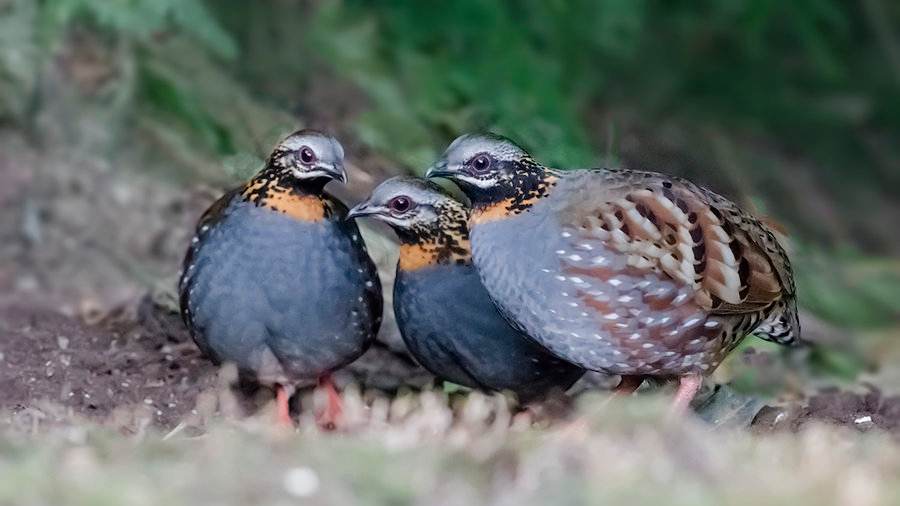Arborophila rufogularis
IUCN
LCBasic Information
Scientific classification
- name:Arborophila rufogularis
- Scientific Name:Arborophila rufogularis
- Outline:Landfowl
- Family:Chickeniformes Pheasants Arborophila
Vital signs
- length:18-28cm
- Weight:220-340g
- lifetime:5-7years
Feature
The beautiful spirit birds of Gaoligong Mountain
Distribution and Habitat
It is found in Bangladesh, Bhutan, China, India, Lao People's Democratic Republic, Myanmar, Nepal, Thailand and Vietnam.
It lives in evergreen broad-leaved forests, coniferous forests, marginal shrubs and tall grasses in low mountain hills and at altitudes below 3000 meters, especially in evergreen broad-leaved forests on both sides of valleys and rivers with rich vegetation.
Appearance
The forehead is dark gray, the top of the head olive-brown with black markings, pale grayish-white eyebrows, broad and long, extending back to the side of the neck with black spots; The cheeks are white and brown, with black spots; Dark brown ear feathers, brown on nape and side of neck, with thick black spots; Back olive brown, slightly maroon luster, but without any markings; Waist, tail cover and back of the same color, but with triangular black spots; Tail olive brown, with black fine spots, upper wing cover and tertiary cover mostly olive brown, with large black spots, base and tip chestnut; The primary flight feathers and primary cover feathers are dark brown, the primary end spots are maroon, the secondary flight feathers and the large cover feathers are dark brown, and the outer part is covered with black wormlike spots and wide chestnut feathers, which gradually turn brown to the end of the feathers. Chin and upper throat brown, dense with large black spots, almost turning the
Details
Rufous-throated Hill Partridge has six subspecies.

The red-throated arboridge is a resident bird. Like clusters, often form small groups of 4-12 animals. Temperament is more bold, not afraid of people, generally in the underbrush and grass activities. He is good at running quickly on the ground, prowling in the underbrush and only taking off when he is in danger and forced to.
The call of the red-throated artridges is a clear, loud monotone whistle that develops into a series of two-syllable hu-hu, hu-hu... The whistle, gradually rising. The mate's call in duet is a quick kew-kew-kew... Noise.
It feeds mainly on the leaves, roots, buds, berries and seeds of understory shrubs and herbs, as well as insects such as beetles, termites, grubs, snails, slugs, centipedes and other small invertebrates.
The breeding period is from April to July, and the nest is built at the foot of the mountain to about 2500 meters above sea level in the evergreen forest under the forest floor. The nest is very simple, mostly using natural pits on the ground or by the female bird digging a small pit in the ground in the low depression, and the inside is covered with grass stems and grass leaves. Some have no internal bedding at all, and sometimes it is only placed on a pile of bamboo leaves under the bamboo forest. The nest is often surrounded by lush shrubs or understory vegetation, which is not easy to see, but sometimes the nest is built in the understory vegetation is sparser and not very hidden. Three to six eggs are laid per litter, usually four to five, up to eight. The size of the eggs ranged from 33.4-44×26.6-33 mm, with an average of 39.2 mm ×29.8 mm. Incubation period is 20-21 days.
Habitat destruction and human economic activities are important factors to the danger of Arborophila, especially excessive deforestation has seriously damaged its habitat environment. Because deforestation is still not under control. Hunted for food. Hunting is another important factor in the population decline.
It was included in the List of Land Wild Animals under State Protection that are beneficial or have important economic and scientific research value (Item 90) issued by the State Forestry Administration of China on August 1, 2000.
Listed in the International Union for Conservation of Nature Red List of Threatened Species (IUCN) for 2016 ver 3.1 - Not Threatened (LC).
Listed in China's "National Key Protected Wildlife List" (February 5, 2021) Level 2.
Protect wild animals and eliminate wild meat.
Maintaining ecological balance is everyone's responsibility!








